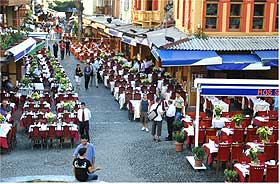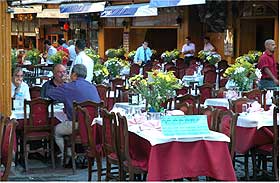

Kumkapi
Go Back to Istanbul Subway Main Page
Kumkapı (meaning 'sand gate' in Turkish) is part of the Eminönü district of Istanbul. It is located along the Marmara Sea. Up to recent times, Kumkapı was mostly inhabited by Armenians, who still have a community school and several churches there. It is also the seat of the Armenian Patriarchate of Constantinople.
Kumkapı has a station on the suburban train line Sirkeci-Halkalı.
The quarter is famous in Istanbul for its many fish restaurants.


Summer weather in Istanbul is usually warm during the day but cools down somewhat at night. Because the city is surrounded by water, there's almost always a light breeze circulating. As evening approaches, people start planning what to do that night, and in the summer that means heading to somewhere open-air to eat fish.
Restaurants abound on both sides of the Bosporus and the road that leads to Atatürk Airport along the Sea of Marmara. But there's another place that used to be a fishing village and isn't right on the shore. It's called Kumkapı, or Sand Gate, and extends inland from the shore road. Just across on the waterside is the wholesale fish market where the fishing boats bring in their catch for sale every morning. The market's more practical than picturesque as the low-slung buildings contain offices involved in the purchase and distribution of the fish. But there's nothing to stop an individual from going there, since sales are retail as well as wholesale.
The fish market is situated on landfill that contains large rocks and the remains of a tower, long since crumbled. There was also a landing that the Byzantine Emperor Michael Palaeologos built/repaired in the 13th century, turning it into a harbor, according to P.G. Incicyan's history of Istanbul. The harbor used to be called Kondoskali (Small Landing). There was traditionally a large Armenian community here because the Byzantines would not let them live inside Constantinople, meaning they settled in areas outside its walls. However, after fatih Sultan Mehmed conquered the city, he allowed them to settle within its walls, in places such as Kumkapı, because there were so few people remaining.
There was also along the coast a palace that belonged to the grandchildren of Sokullu Mehmed Paşa, who was Sultan Süleyman the Magnificent's grand vizier and another belonging to a family called the sons of Ibrahim Han, who were the offspring of another grand vizier of Süleyman's. In the city square there was a hammam, soup kitchens, a mausoleum and several two-story houses. Armenians and Greeks were predominant in the area's population.
The 17th century, Ottoman travel writer Evliya Çelebi lists Kumkapı among the areas with the most meyhanes while in Komurciyan's history of 17th century Istanbul, Kumkapı is described as having more and more “cheerful meyhanes” than the neighboring district of Samatya. It was apparently a district that had once contained gypsy locksmiths but Grand Vizier Köprülü had torn down the huts in which they lived and scattered them elsewhere. There also were some men who acted as pimps for the gypsy women and these too were gotten rid of.
The area already had a mixed reputation in the 17th century despite the mansions that lined the shore.
Kumkapı today:
What is Kumkapı today? Most Turks would think of the series of two and three-story buildings, approximately 50, that line the main street, now closed to traffic. On the ground floor of these buildings would probably have been a store of some sort and above that, apartments for accommodation. Today those stores have been converted into restaurants, one after another on both sides of the road. Of course it makes sense for what was once a fishing village to sell fish. But while Turks call them fish restaurants, it's hard to tell them from the traditional meyhanes (literally wine houses, although rakı is generally the drink of choice). The only difference would appear to be that in meyhanes there is a specific décor, and Turkish music, especially fasil, is often played live.
Kumkapı began to grow in the 17th century but not because of the fish market -- it is a latecomer from the 1980s when the market on the Golden Horn was closed down. The “village” is actually the location of the Armenian Patriarchate and the patriarchal cathedral, just a few streets over from the main street. Many Armenian families still live in the area. The church has been rebuilt several times because of fires and the current cathedral only dates to 1913. Many of the large, old Greek houses today are used as depots, since their inhabitants long ago moved to Greece or elsewhere.
At one time or another, people from all of Istanbul used to go for the fish at the local restaurants, many of which were run by Armenians. The most famous was Hacı Agop, a restaurant officially classified as a meyhane that still exists, although its founder for whom it was named has long since gone to meet his maker. The area caught on with Istanbulites who found it a pleasant outing with good food, good drinks and an enjoyable ambience but it went downhill in the 1970s when the economy was bad, inflation high and the possibility of a terrorist attack loomed. It no longer seemed the place to go.
The people of Istanbul have taken to restoring and sprucing up old buildings with a vengeance, especially since they see the value in it. In Kumkapı, this happened in the second half of the 1980s. Encouraged by the local municipality, the traffic pattern was changed and cars can no longer go through the main thoroughfare, except early in the morning before the restaurants open. Then the road and sidewalks were torn up section by section and repaved with broken gray rock laid on sand, a favorite paving technique in Istanbul that makes it hard for women wearing high heels to walk safely. The facades on all the restaurants were renewed, at least on the ground floor, to give a modern and more uniform look to the place. During the summer months, tables with white clothes are placed outside each restaurant and adorned with bunches of flowers.
As you pass each restaurant, the waiters try to attract your attention to eat at their place, but they do it nicely. Eventually you find the very place where you want to eat and sit down. (We prefer Hoş Seda for its good food and friendly service.) The waiters immediately make a fuss over you and bring out a tray filled with cold hors d'ouevres for you to choose from, even as they take your drink order. From there in a leisurely fashion, you're led to choose hot starters, freshly made and crisply crunchy. Then comes the main course with a dozen or more types of fish to choose from and a dozen or more ways in which they can be prepared. Fresh fruit for dessert is usually the norm after the feast, drinks and great conversation, topped off with Turkish coffee.
The evening is fun because the more crowded the area is, the more excitement and noise there is. Although most of the restaurants don't feature Turkish music, gypsy musicians work the diners for whatever they can get. Some will even sing along with the music while others try their skill at belly dancing.
Did the cosmetic makeover work? Well, yes. The place attracts tourists, sometimes busloads of them at night. The pace is more leisurely during the day and almost all the restaurants are open from lunchtime onwards offering all you would have in the evening. The spic-and-span atmosphere is also reassuring to customers, many of whom are from Istanbul and enjoy bringing visitors to Kumkapı for a colorful and interesting experience in a colorful and interesting place.
Go Back to Istanbul Subway Main Page
Hop On Hop Off City Sightseeing Istanbul - City Tour - Ho Ho Points
![]()
Home |
Ana
Sayfa | All About Turkey |
Turkiye
hakkindaki Hersey | Turkish Road Map
| Historical Places in Adiyaman |
Historical
Places in Turkey | Mt.Nemrut |
Slide
Shows | Related Links |
Guest
Book | Disclaimer | Send a Postcard | Travelers' Stories |
Donate a little to help |
Istanbul Subways |
Adiyaman Forum
|
|